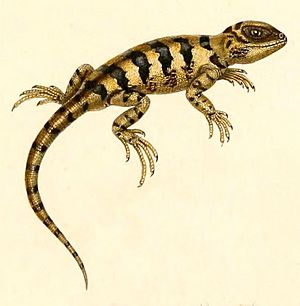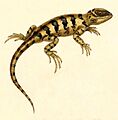D'Orbigny's banded anole facts for kids
Quick facts for kids D'Orbigny's banded anole |
|
|---|---|
 |
|
| Conservation status | |
| Scientific classification | |
| Synonyms | |
|
Pristidactylus fasciatus, also known as d'Orbigny's banded anole, is a type of lizard found only in Argentina. This interesting reptile is part of a group of lizards called Pristidactylus. It was first described by scientists Alcide d'Orbigny and Gabriel Bibron in 1837.
Contents
About d'Orbigny's Banded Anole
D'Orbigny's banded anole is a fascinating lizard. It is known for its unique appearance. Like all lizards, it is a reptile. This means it is a cold-blooded animal. It relies on its environment to control its body temperature.
What Does It Look Like?
This lizard gets its name, "banded anole," from its markings. It likely has stripes or bands on its body. These patterns help it blend into its surroundings. Lizards often use camouflage to hide from predators. They also use it to sneak up on their prey. The exact colors and patterns can vary. This might depend on where the lizard lives.
Where Does It Live?
D'Orbigny's banded anole lives only in Argentina. This makes it an endemic species. Endemic means it is found nowhere else in the world. Argentina has many different environments. These include mountains, forests, and grasslands. Lizards usually prefer specific habitats. They need places where they can find food and shelter. They also need sunny spots to warm up.
What Does It Eat?
Most lizards are insectivores. This means they eat insects. D'Orbigny's banded anole likely eats a variety of small creatures. These could include crickets, spiders, and other invertebrates. Eating insects helps control insect populations. This makes lizards an important part of their ecosystem.
Why Is It Important?
Studying lizards like d'Orbigny's banded anole is very important. Scientists learn about how ecosystems work. They also learn about biodiversity. This lizard is listed as "Data Deficient" by the International Union for Conservation of Nature (IUCN). This means there isn't enough information about it. Scientists don't know how many of these lizards exist. They also don't know if its population is growing or shrinking. More research is needed to protect this unique animal. Learning about these lizards helps us understand nature better. It also helps us protect all living things.
Images for kids
 In Spanish: Lagarto de D'Orbigny para niños
In Spanish: Lagarto de D'Orbigny para niños



